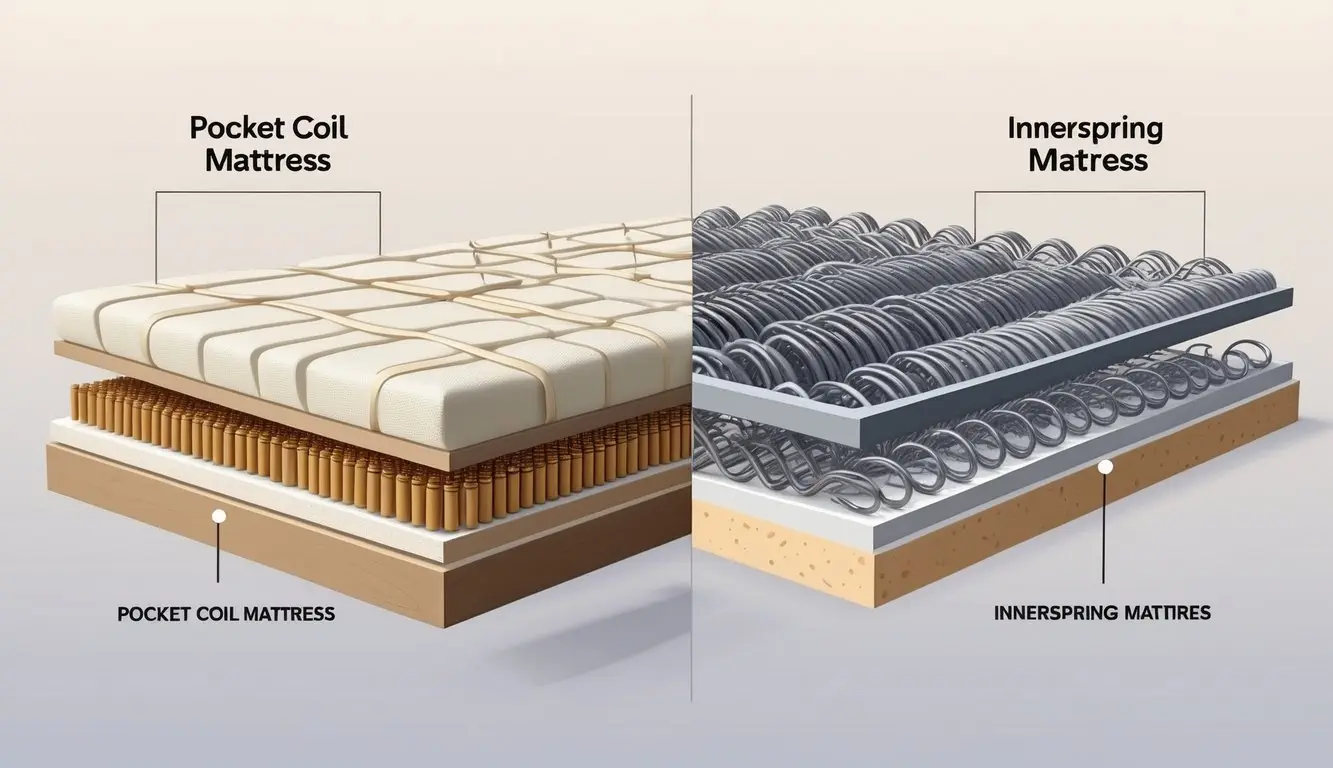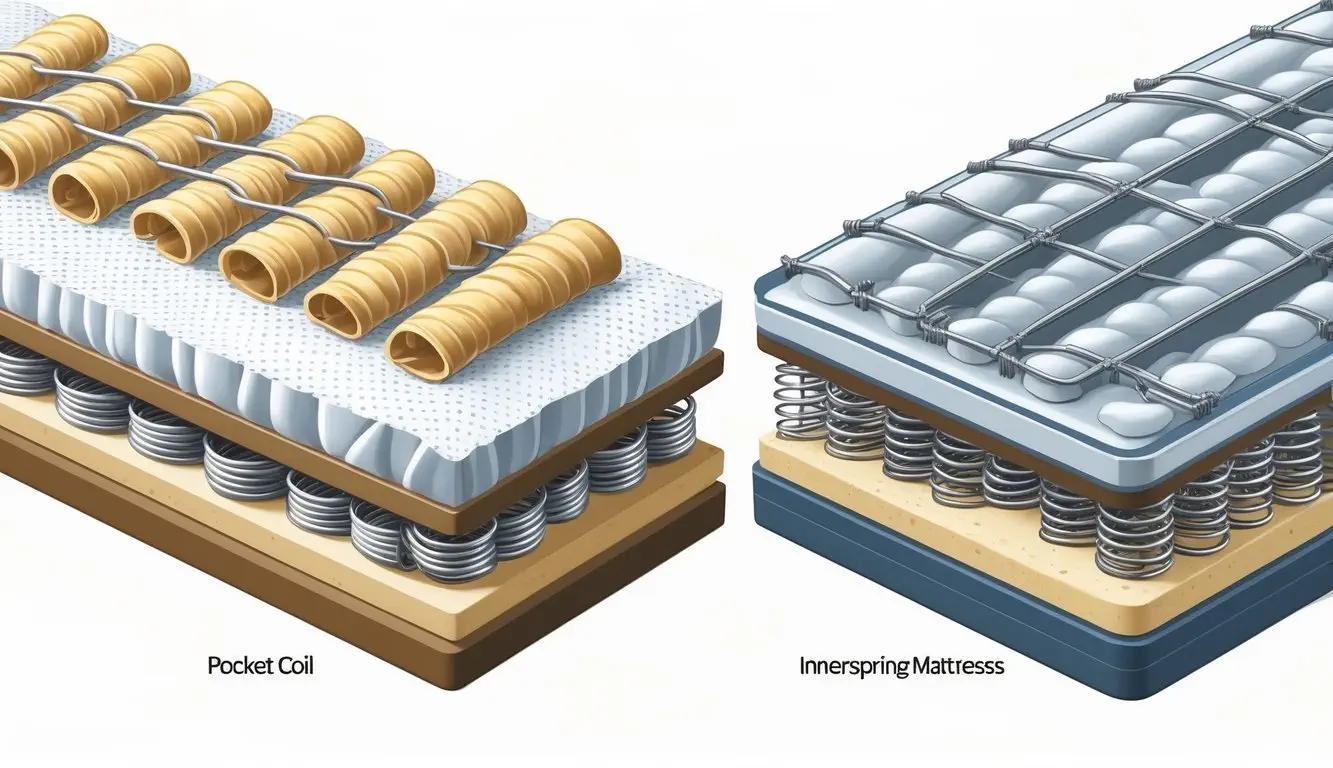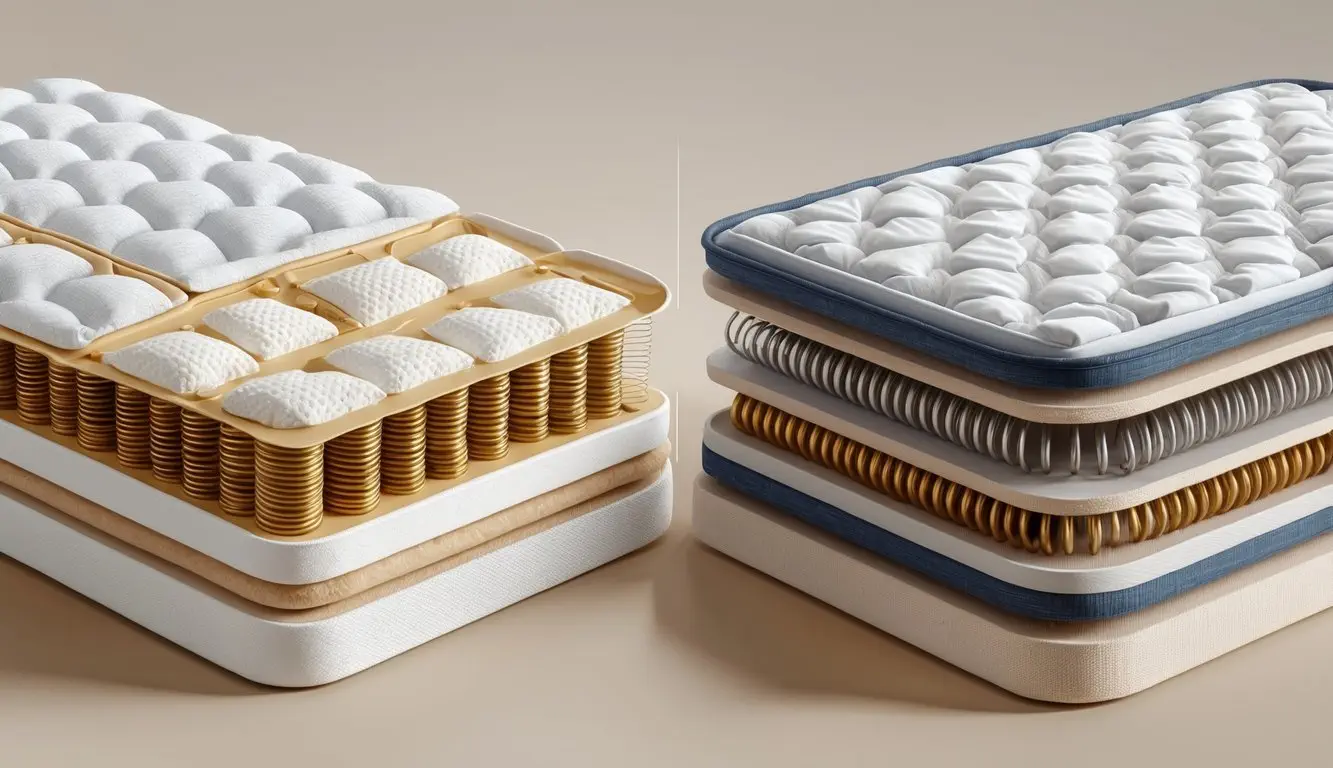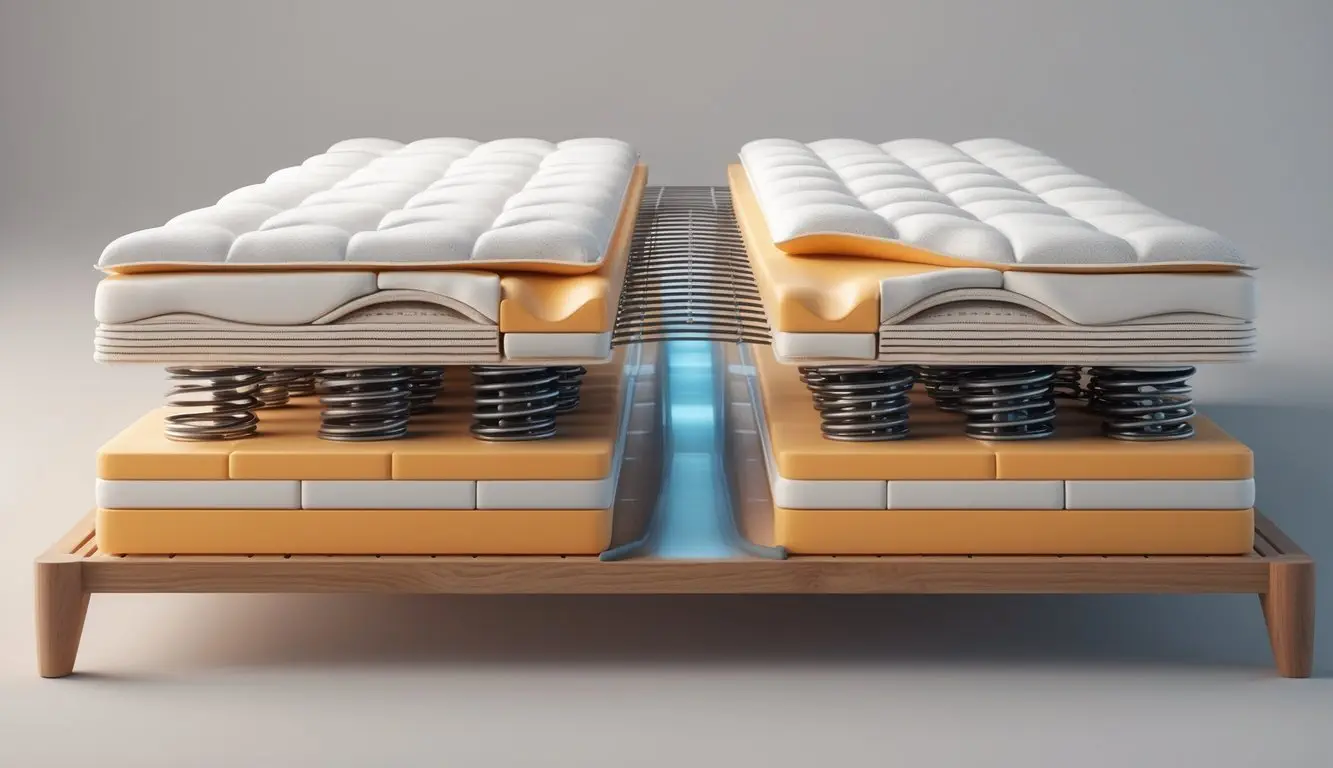Many people looking to buy a new mattress hear about pocket coil and innerspring types. Both options use springs for support, but they are built differently and feel different to sleep on. Pocket coil mattresses have springs that move individually, while traditional innerspring mattresses have springs that are all connected.

Choosing the right mattress depends on how much support, motion control, and comfort someone needs. People who want less movement and a more customized feel may prefer pocket coils. Those who like a firmer, supportive surface might choose an innerspring mattress.
Understanding these differences helps shoppers make a better choice for their sleep. Each type has unique benefits that can make a big difference in nightly comfort.
Pocket Coil vs Innerspring Mattresses – An Overview

Mattresses with coils have been popular for many years. Innerspring and pocket coil types use different designs, which affects how they feel, support the body, and control motion.
What Is an Innerspring Mattress?
An innerspring mattress uses a network of interconnected steel coils. These coils are all linked together, so when pressure is applied to one spot, the surrounding coils also move. This can create a bouncy and firm surface.
Main features:
- The coil structure gives lots of support.
- They often feel firmer, which some people prefer for back support.
- Because the coils move together, motion on one side can be felt on the other side.
- Innerspring mattresses usually have a thinner comfort layer on top, often made of fiber or foam.
These mattresses can be cooler than foam beds. Air moves freely between the coils, which can help prevent heat buildup overnight. They are often among the most affordable options for those looking for basic support.
What Is a Pocket Coil Mattress?
A pocket coil mattress uses springs as well, but each coil is wrapped in its own fabric pocket. This design keeps the coils separate from each other. If one coil is pressed down, the coils next to it do not move as much.
Key points:
- The separate coils reduce motion transfer, which means less movement is felt from a partner.
- Each coil can adjust to the shape of a person’s body, providing targeted support.
- The most common comfort layers include foam or fiber for extra softness and cushioning.
Pocket coil mattresses often feel less bouncy than basic innerspring options. They are also better at minimizing pressure on joints and spine, making them a popular choice for couples or those with back pain.
Core Differences Between Pocket Coil and Innerspring Mattresses

Pocket coil and innerspring mattresses use different types of coils and construction. These differences affect motion transfer, support, and how long the mattress lasts.
Coil Construction and Technology
Pocket coil mattresses use springs that are individually wrapped in fabric. Each coil moves on its own, so the coils can react independently to pressure.
In contrast, innerspring mattresses have springs that are all connected together, usually with a wire or mesh. When one coil moves, others nearby also move.
| Feature | Pocket Coil | Innerspring |
|---|---|---|
| Coil type | Individually wrapped | Interconnected |
| Movement | Individual response | Linked movement |
| Coil count (average) | Higher, often over 800 in queen size | Lower, often 200–600 |
A higher coil count in pocket coil mattresses usually means more targeted support. The difference in coil design is one of the main reasons these mattresses feel and perform differently.
Motion Isolation and Support
Pocket coil mattresses are better at reducing motion transfer. Because each coil is separate, movement on one part of the bed is not as easy to feel on another part.
For people who share a bed, this can mean less disturbance when one person moves or gets up.
Innerspring mattresses do not isolate movement as well. Since the coils are linked, motion travels across the bed. This can make it less comfortable for couples if one person is a restless sleeper.
Support is also affected by design. Pocket coil beds offer targeted support to different parts of the body. Innerspring beds give firm, even support but may not adjust as easily to body shape.
Durability and Longevity
Durability can depend on the coil material and how the mattress is made.
Pocket coil mattresses tend to keep their shape longer because each spring works separately. They are less likely to sag in the middle over time, especially with a higher coil count.
Traditional innerspring mattresses may wear out faster, especially if the coils are thin or there is a low coil count. Sagging and body impressions are more common.
Longevity in both types can be affected by the materials used in the comfort layers and how the mattress is cared for. However, pocket coil designs generally have a slight edge in lasting longer with regular use.
Comfort and Sleep Experience

Pocket coil and innerspring mattresses offer different levels of support, body pressure relief, temperature control, and edge strength. Each mattress type uses unique technology to affect how someone sleeps and feels through the night.
Pressure Relief
Pocket coil mattresses use springs that are wrapped in fabric and work independently. This helps them adjust to the shape of a person’s body and provide support where it is needed most. Side sleepers and people with back or joint pain may find that a pocket coil mattress eases discomfort by keeping the spine in a good position.
Innerspring mattresses, on the other hand, use connected coils. When one coil is pressed down, movement spreads across the mattress. This makes them less effective at targeting pressure points. People who need more support for joints or prefer less movement may not get as much relief with a standard innerspring mattress.
Pocket coil mattresses can help reduce partner disturbance too. Movement stays in one spot, so one person turning or moving is less likely to disturb someone else.
Temperature Regulation
Temperature control matters for people who tend to overheat or get cold while sleeping. Innerspring mattresses usually have more space between the coils. This design helps air flow easily and removes trapped heat, which keeps the mattress cooler during the night.
Pocket coil mattresses also allow for some air flow, but the fabric wrapping around each coil may lower air movement slightly. Some models use cooling gels or breathable fabrics to help with heat control. Still, traditional pocket coils may sleep warmer than open-coil innerspring mattresses.
Those wanting a cooler sleep may lean toward innerspring mattresses, while people who do not overheat might prefer pocket coils for greater support and motion control.
Edge Support
Edge support affects how stable the sides of the mattress feel when someone sits or lies on the edge. Innerspring mattresses usually have a strong border wire or firmer coils along the edges. This makes them feel steady and less likely to sink when someone gets in and out of bed.
Pocket coil mattresses may have additional edge support, such as thicker coils or dense foam, but performance varies across brands. Some lower-quality pocket coils lack solid edge support and may sag at the sides over time.
A comparison:
| Feature | Pocket Coil | Innerspring |
|---|---|---|
| Typical Edge Support | Moderate-Strong¹ | Strong |
| Feels Sturdy at Edges | Sometimes | Usually |
| Sagging Over Time | Possible | Less likely |
¹ Depends on extra edge reinforcement features.
Strong edge support is most important for people who sit on the sides of their bed or need the full mattress size for sleeping space.
Suitability for Different Sleepers

Pocket coil and innerspring mattresses work differently for people based on their sleep style and preferences. Each type offers specific benefits related to comfort, support, and movement isolation.
Back, Side, and Stomach Sleepers
Back sleepers usually need solid support for spinal alignment. Pocket coil mattresses provide targeted support since each coil works individually. This can help back sleepers avoid sinking too much, keeping their backs straight.
Side sleepers often need pressure relief at the shoulders and hips. Pocket coils are better here because they contour more closely to the body and can ease pressure points. Innerspring mattresses, with their linked coils, offer even support but may feel firmer and sometimes put extra pressure on the hips and shoulders.
Stomach sleepers should look for a mattress that keeps their midsection from sagging. Traditional innerspring mattresses tend to be firmer and can support stomach sleepers well. However, a too-soft pocket coil mattress may cause bowing in the back, which may lead to back pain.
In summary:
| Sleep Position | Pocket Coil Benefits | Innerspring Benefits |
|---|---|---|
| Back | Targeted support | Even, firm support |
| Side | Better pressure relief | Can feel too firm |
| Stomach | Good if firm, risk of sagging | Consistent, firmer support |
Couples and Motion Transfer
Motion transfer is important for couples who share a bed. Pocket coil mattresses are better at isolating movement because each coil moves alone. When one person rolls over or gets up, the other person feels less bouncing or shaking.
Innerspring mattresses tend to move as a unit because the coils are all connected. This means more motion spreads across the bed. If a partner moves at night, the other may feel it and wake up more easily.
People who are light sleepers or get up at different times may prefer pocket coil mattresses for a quieter night. Couples who don’t mind feeling movement or who are heavier may be fine with innerspring mattresses since they can offer firmer total support.
Key differences:
- Pocket coil: Less motion transfer, better for undisturbed sleep
- Innerspring: More bounce, more likely to feel movement
Maintenance and Care

Both pocket coil and traditional innerspring mattresses need routine care to stay comfortable and last longer. Cleaning habits and expected lifespan differ based on the mattress type and how it’s treated.
Cleaning and Upkeep
Mattress care starts with regular cleaning. Both types should be vacuumed every few months to remove dust, allergens, and dirt. Spot clean stains using a small amount of mild soap and water. Avoid soaking the mattress, as too much moisture can damage the coils and lead to mold.
Both kinds of mattresses benefit from a mattress protector. This simple layer helps block spills, sweat, and dust mites. For deeper cleaning, always follow the care tag on the mattress. Rotate the mattress head-to-foot every 3 to 6 months to keep the surface even. Flip only if the mattress is designed for two-sided use—many modern models are not.
If possible, keep the mattress on a sturdy, supportive base. Weak bases let the mattress sag, which shortens its life and can create discomfort.
Expected Lifespan
A quality pocket coil mattress typically lasts 7–10 years. Its individual springs tend to hold shape and support longer than older innerspring designs. Traditional innerspring mattresses often last between 5–8 years, as connected coils may start to sag or lose support sooner.
Several factors affect lifespan:
- Mattress quality and materials
- Weight and number of sleepers
- Frequency of use
- Care and cleaning habits
Proper maintenance helps both mattress types last longer, but pocket coil models generally have the edge in durability. Signs it’s time to replace a mattress include sagging, lumps, or lost support. Waiting too long can affect sleep quality and comfort.
Cost and Value Considerations

Mattress costs can vary widely depending on design and brand. Warranties and trial periods also influence the total value a buyer receives.
Pricing Differences
Pocket coil mattresses almost always cost more than traditional innerspring mattresses. This is because pocket coils use many individual springs wrapped in fabric sleeves. The extra materials and construction increase production costs.
A basic innerspring mattress can start at around $200 for a twin size, while a pocket coil mattress usually begins at $300 or more. Queen and king sizes see bigger price differences. For example:
| Mattress Type | Average Twin Price | Average Queen Price |
|---|---|---|
| Innerspring | $200-$600 | $300-$800 |
| Pocket Coil | $300-$1,000 | $500-$1,500 |
Some brands offer hybrid models, combining pocket coils with memory foam. These can cost even more. Sales and promotions can sometimes lower prices, but pocket coil mattresses usually remain more expensive.
Warranty and Trial Periods
Warranty and trial periods add extra value. Many innerspring mattresses include warranties of 5-10 years, but coverage for defects is usually limited. Pocket coil mattresses often feature 10-20 year warranties, with some brands offering limited lifetime coverage for certain models.
Trial periods are common with both types. Some brands let customers test the mattress for 90 to 365 nights at home. Companies may offer free returns if the customer is not satisfied. Pocket coil mattresses typically offer longer trial periods and easier return policies, especially from online retailers.
Buyers should read warranty and trial details carefully. Exclusions and required conditions may affect what is covered and how to make a claim if a problem occurs.
Conclusion

Both pocket coil and innerspring mattresses offer unique benefits.
Pocket coil mattresses have coils wrapped in fabric, keeping them separate. This design can reduce motion transfer and offer better support for some sleepers.
Innerspring mattresses use coils that are connected together. These often provide a firmer, bouncier feel and better airflow.
| Feature | Pocket Coil | Innerspring |
|---|---|---|
| Support | More targeted | Even, firm |
| Motion isolation | Higher | Lower |
| Airflow | Moderate | High |
| Durability | Often higher | Varies |
Key points to consider:
- Personal comfort matters most; try both types if possible.
- Look at durability and support needs.
- Budget may influence the decision, as pocket coil models can be more costly.
Finding the right mattress can lead to better sleep and comfort. People should weigh the pros and cons of each before choosing.
Frequently Asked Questions

Pocket coil and innerspring mattresses differ in support, comfort, and common issues. Each type has unique strengths and weakness in terms of durability, performance, and sleep quality.
What are the pros and cons of pocket coil mattresses compared to innerspring mattresses?
Pocket coil mattresses provide better motion isolation because each coil works independently. This can reduce movement disturbance for people who share a bed.
Innerspring mattresses often offer a bouncier feel and usually cost less. However, pocket coil mattresses tend to contour more to the body, while traditional innerspring mattresses can sometimes cause pressure points.
How does the durability of pocket coil mattresses compare to that of innerspring mattresses?
Pocket coil mattresses usually last longer because the coils wear out at different rates, which keeps the support more even over time. Traditional innerspring mattresses may sag sooner as the spring system is connected, so if one area sags, others might as well.
Can pocket coil mattresses provide better support and comfort than traditional innerspring beds?
Many people find pocket coil mattresses more supportive because the springs adjust individually to the body’s shape. This helps reduce pain and makes the bed more comfortable for different sleeping positions. Innerspring mattresses might not contour as well, which can cause discomfort for some sleepers.
What are the common issues associated with pocket coil mattresses?
Pocket coil mattresses can be heavy, making them harder to move. Over time, the fabric pockets that hold each coil may tear, which can reduce the mattress’s support. Some people may notice uneven settling or feel the edges sink more than the middle.
Are hybrid mattresses superior to innerspring and pocket coil mattresses?
Hybrid mattresses combine coils with foam layers. This often gives better pressure relief and support than traditional innerspring or standard pocket coil beds. However, whether a hybrid mattress is “superior” can depend on individual sleep needs and budget.
In terms of overall sleep quality, which is preferred: a pocket spring or a foam mattress?
Some people prefer pocket spring mattresses because of better airflow and a slight bounce, which can feel cool and responsive. Foam mattresses contour deeply to the body and absorb motion well, which suits those wanting a “hugged” feel. Choice depends on personal comfort and support needs.